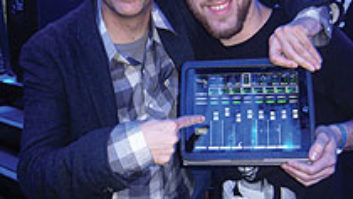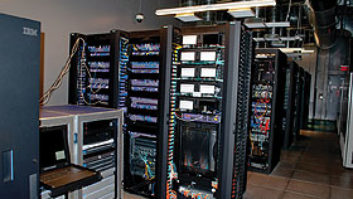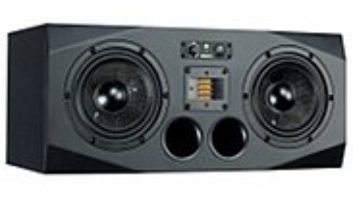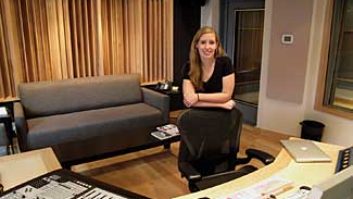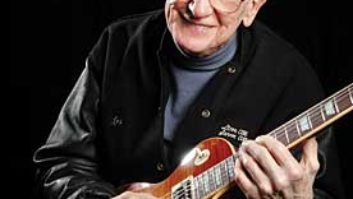Virtually everything can now take place virtually. The transfer of audio data via copper wire and, increasingly, the ether, has been a growing trend in professional audio recording, editing, mixing and playback for the past decade. Consequently, it’s only logical that the suppliers of the technology used in making music would move online, as well. But is it a better way of buying equipment?
“It’s another way,” says Ray Maxwell, who was recently named general manager for Digibid.com, a two-year-old online pro audio equipment auction site. (Digibid is owned by IndustryClick, the business-to-business Internet subsidiary of Primedia, Mix’s parent company.) Like many in this rapidly expanding niche, Maxwell is quick to point out that online ventures are not intended to replace brick-and-mortar equipment retail operations, but rather to complement them, a sentiment voiced in the larger world of e-commerce as online retailing took center-stage during last year’s holiday selling season. James B. Kersten, CEo of Iowa-based Musichotbid.com, echoes that observation in an online FAQ statement: “on the contrary, we will help retail outlets by providing them another way to reach the public. Perhaps the greatest benefit is the fact that we can offer them a variety of ways to reach the public: auctions, store front or classified ads at a comparatively low cost to going into e-commerce themselves.”
Digibid, Musichotbid, Sweet water.com, Musiciansfriend.com, Harmonycentral.com, Fullcom pass.com-the list of sites that offer pro audio gear is growing. But their proliferation underscores the fact that the various levels of technology used to create, compose, record, edit, mix and manipulate music have undergone a tremendous convergence in recent years. Anyone who has been to both a NAMM show and an AES convention in the past year is bound to have noticed a significant amount of overlap of products and technology platforms. No one’s selling guitars at AES, nor 120-input consoles at NAMM, but just about everything in between can be found on either show floor, and is fair game for these sites.
The sites can’t seek to re-create the sense of community that conventions offer-a larger, less defined version of the cacophonous village that is a musical equipment store, like one of the half-dozen or so that line Manhattan’s West 48th Street. “We don’t have a showroom,” says Maxwell. “But I’m convinced that this model represents the future, a significant opportunity for creating an environment in which pros can congregate.”
Sweetwater Sound, a 21-year-old Fort Wayne, Ind., company that grew from a recording studio into a storefront, got into catalog sales before going online in 1995. The company now has dedicated 15 of its 200 employees to its growing Internet-based sales business, and director of marketing Dave Stewart stresses customer support and a friendly atmosphere as one reason the company has done well over the years. “We’ve been selling pretty sophisticated stuff over the phone for years, so we think we can apply that to Net-based sales,” he says. He says that Sweetwater is the nation’s largest Pro Tools dealer. Most of Sweetwater’s sales are to the MI market, and mostly of new equipment.
Ray Maxwell says that Digibid is aiming at a more service-oriented level than its competitors, with more used pro audio gear available on its auction site. This, he says, is an outgrowth of the company’s foundation, which was a studio liquidation service and pro audio auction service started by Digibid founder Hamm Brosious. Brocious also founded the Audio Techniques pro audio retail service (later sold to Manny’s Music) and remains a consultant to Digibid while his son and Digibid co-founder, Matt Brosious, works as IndustryClick’s vice president of e-commerce.
Although more focused on the upper-end of the technology spectrum than other sites, Digibid’s modus operandi is similar to that of the other auction sites. Sellers register for free with the service and can then list used gear online for sale. Digibid acts as the intermediary and takes a 10% commission. others, like Musichotbid, offer sliding-scale commission rates, taking between 3% and 5%. Digibid holds the purchase price in escrow, giving the buyer 72 hours to inspect the purchased item and make sure that it lives up to its online representation. If there is a dispute, Digibid will intervene by possibly canceling the transaction and returning the money, or by asking the seller to adjust the price.
Not all the gear is used. Digibid made a $16 million purchase of musical instruments and low- and mid-market pro audio gear-enough to fill 700 shipping pallets-from the barter company Active International, a move that Maxwell characterized as “defensive,” intended to prevent another mass merchant from purchasing the gear and possibly flooding the market, hampering Digibid’s ability to grow. Maxwell says the fruits of this successful bid will be put onto the auction site for sale incrementally.
BRICK & MORTAR RESPONSE”Caveat emptor” is an implicit component of all online sales of pre-owned equipment. That’s generally the case with used equipment sales at brick-and-mortar facilities, as well, but those facilities assert that they are in a much better position to evaluate used equipment as it comes in. “The thing we’re focused on is personal service, and that’s one thing that [online] auction services can’t offer,” says Dave Malekpour, president of Professional Audio Design, a Boston-area new and used equipment dealer and the sole authorized reseller of pre-owned SSL consoles in North America. “You can look at thousands of items online, and if you know exactly what you’re looking for, that’s fine. But when you need help finding exactly what’s right for your situation, then you need personalized service. And this is an industry where that has been the norm until recently.”
Online retailers realize that this industry niche needs to evolve before it can expand much further. Sweetwater’s David Stewart concedes that most of the sites, including his, are mostly static displays. “There needs to be an increase in the amount of interactivity they offer,” he says. “That’s one of the things that everyone has to improve.”
“It doesn’t take a lot to sell an XLR connector,” says Mike Bogen, director of pro audio products at Manhattan’s Dale Audio. “But we’ve invested hundreds of thousands of dollars in a facility where people can come in and really get a sense of what it is they need and what they’re actually buying. It’s not the box that sells, but the human interface it uses. Every workstation does cut-and-paste with keystrokes. But does it take four strokes or seven to accomplish the task? You gonna find that out online?”
Many of Bogen’s 20-plus years in the industry have been spent in retail sales and broadcast engineering. His time as a radio engineer at New York’s famous WHN-AM is displayed when he asks a caller to “stand by!” instead of to “hold on.” But he agrees that he is from a generation that grew up with the chummy, familiar model of knowledgeable sales people who were as intimate with which pin was hot as he was. The generation now in its ascendancy in pro audio was weaned on MTV and MacWarehouse, buying computers and other gear from catalogs and online, sight-unseen, except for beauty shots in the magazines. And Bogen, who says he likes to “press the flesh” as a salesman and take a personal interest in customers’ needs, cautions that the virtual commercial environment not only takes the personal aspect out of the equation but also lends itself to fraud. “I like buying watches on the Internet,” he says, “but I won’t buy unless I know the reputation of the company. There’re too many counterfeit products out there. When it comes to microphones, how do I know what shape the ribbon is in, or if all the parts are original?”
The online sellers respond that there are scams perpetrated occasionally. “People do misrepresent items at times,” concedes Digibid’s Maxwell. “People also put the same item up on [multiple] auction sites, then take the best bid from one of them and renege on the other bids. But people are legally bound to sell an item they put up for auction. When we find people doing that, we terminate their memberships.”
The online sellers also say that auction sales are only part of what they offer members. other perks include news services, reviews and general industry information. Many, like Music hotbid, which published the Midwest Musicians Hotline newsletter (containing used gear classified advertising), grew out of the musical instrument gear publishing industry. And for their part, most of the brick-and-mortar sales operations also now have Web sites listing gear for sale, and if you were to see a microphone or a preamp that you fancied, they’ll be more than happy to box it up and ship it to you upon getting your credit card information. The only difference between the transactions is that a live telephone call was made. And others, like Malekpour, are contemplating expanding the range of their Web sites in the coming months.
PART OF THE LARGER PICTUREThe MI and pro audio industries combined are estimated at more than $15 billion in the U.S. alone; the used equipment market is unquantifiable, because much of it is based on person-to-person transactions and includes barters and trades. But the overall numbers are potentially huge, underscoring the sentiment of many of those we interviewed that there’s still room for everyone at the moment.
However, the long-term stakes are huge. Consolidation has been an overarching theme in the technology industries for several years and shows no sign of abating. Digibid was acquired by IndustryClick, and, not surprisingly, two of the FAQs on the Musichotbid Web site refer to the possibility of that company acquiring others or being acquired itself. (Kersten says that there are no plans for the former, adding, “We would consider acquiring other e-commerce companies if they have a certain number of listings and users on their site that would be complementary to ours.” Regarding the latter question he says, “While we will not disclose names of possible suitors or investors, we have been approached by a number of well-known companies that recognize the growth potential of our niche.” And to the obligatory question about going public, Kersten wrote that an IPO is an option later this year.)
Clearly, the Internet-based sales sites are vulnerable to both the exigencies of the Internet business as well as those of pro audio. But those are complications retailers can live with, because the Web frees them from warehouse and storefront rents, as well as other overhead expenses. In fact, most of the e-commerce sites are run with fewer than a dozen employees, including executive management. That fact alone positions them very well in an industry that has been moving undeniably and more deeply toward a commodity model for more than a decade-one in which profit margins continue to erode as competition drives prices down. In many ways, the arrival of Internet-based commerce is serendipitous with the large-scale down-marketing of the pro audio industry itself.
The easy observation is that this sounds good for the consumer. However, price is not the only consideration. The deeper implication is that the further this model progresses, the more potential it has to undermine the sometimes-tenuous pricing structure of the entire industry. Consider the development costs of certain very expensive, complex digital platforms, such as large-format consoles; these costs are often never recouped, but the fruits of the R&D are later leveraged into other, more successful products, ones with wider benefits to the industry as a whole. This is similar to the pharmaceutical industry’s development of so-called “orphan drugs,” aimed at very rare but critical illnesses; the research costs of developing such drugs may never be recouped by selling those specific drugs, but the collateral benefits inevitably find their way into more mainstream drug products that might never have been produced without the subsidized research that went into the less marketable products. So, the fear is that the pricing structure-often called the “minimum advertised price” or MAP-of pro audio equipment disappears, it could take with it the implicit market subsidies that support product development.
On the other hand, this sort of concern was voiced by the more than 300 auto-makers that were in business in the U.S. in the first decades of the 20th century. Then Henry Ford radically changed the way cars were developed and manufactured and became the catalyst for massive consolidation within that industry. What’s irrefutable is that e-commerce pro audio sales are here to stay, and the conventional retail apparatus is going to have to accommodate it, just as conventional studios learned that there was no way to close the lid on the project studio genie once it was let loose from its bottle.
STILL MAKING WAVES IN THE STUDIO WORLDNorbert Putnam has had relationships with recording studios the way big-band leader Artie Shaw had wives. Starting with Quadraphonic Studios in Nashville in 1970, Putnam, a bass player and part of the Muscle Shoals session crew brought to Nashville by Elvis Presley producer Felton Jarvis in 1965, has had a string of facilities in Music City. He has owned The Bennett House, Digital Recorders, Georgetown Masters, and now, Cadre Studios, which opened in April in Memphis in a 1928 Art Deco-style former bank building. All of these facilities were intended to support Putnam’s ambitions as a producer, and they have served him well; his production credits include records for Jimmy Buffett, Joan Baez, Dan Fogelberg, Kris Kristofferson, Brewer & Shipley, Pousette Dart Band, Donovan, John Hiatt, J.J. Cale, the Flying Burrito Brothers and the New Riders of the Purple Sage. If it wasn’t stone country and it wanted to come to Nashville, it usually wound up on one of Putnam’s many doorsteps.
Putnam’s first studio work was in Muscle Shoals, but his earliest memories are not terribly high-tech. The manager of the local movie theater would offer musicians free passes to the movies in exchange for playing on his demos, recorded in the dilapidated offices above his father’s corner drugstore. They played to an old Roberts mono tape recorder with only enough microphones to record half the drum kit, and a Heathkit recording console with no volume fader-the fade-outs were accomplished by turning the console off and letting the tubes die out.
The years in Muscle Shoals, at places like Rick Hall’s FAME Studios, gave Putnam a taste for the business side of recording. But Hall also imbued him with a fundamental business philosophy. “When I was young and working in Muscle Shoals, I didn’t know about inventing bass parts, so I was copying other people’s parts,” Putnam recalls. “If a song sounded like a Drifters’ song, me and the drummer would play a Drifters’ part. Then one day Rick came out and said to me, ‘We already have Drifters records; you need to come up with something new.’ And I’ve tried to apply that to every studio I’ve ever owned.”
When Putnam and keyboardist David Briggs opened Quadraphonic in Nashville in 1970, Music Row was a staid place, with label-owned studios and union engineers who, as Putnam puts it, “were lethargic and set for life; they didn’t need to work at it.” The pair took an old house off the Row and made it into a place staffed by young engineers whom they encouraged to work freelance, charge more but experiment and push the sonic envelope of the day. “We also charged the highest rates in the city,” he says. “one hundred and fifty dollars an hour, $165 in the evenings and weekends. And you know what? People were lining up to pay that, because we had the engineers working here who could get the rock sounds. We also had one of the first 16-track 2-inch decks and were the first to put in Dolby A. We also had the first automated MCI console in Nashville, the one I mixed [Jimmy Buffett’s] ‘Margaritaville’ on. We brought something to Nashville that it hadn’t seen before, and that made Quad work.”
Putnam and Briggs sold Quad in 1980 for $1 million to a group of doctors from Atlanta. “We paid $30,000 for the lot and the building in 1970 and put about $125,000 into it in terms of equipment,” he estimates. “The second year we were open the business grossed $440,000 in sales. The economics of studio ownership were great then. But after I sold it, I swore I’d never do it again.”
That promise to himself lasted all of six months. He purchased an 1875 mansion called the Bennett House in the Nashville suburb of Franklin, intending to turn it into a combination residence and private studio. But soon he got calls from Kris Kristofferson, Mickey Newbury and Dan Fogelberg, all of whom wanted to work with him again. In the meantime, Putnam had hired the sous chef from Julian’s to prepare meals at the studio. When singer Amy Grant went to work there in the early 1980s, she was so taken by both the studio and the chef, she told her manager that she wouldn’t work anywhere else. “The chef made that studio,” laughs Putnam. “[Producer and Capitol Records head] Jimmy Bowen told me no one would go to a studio in Franklin,” says Putnam. “Now, how many studios are there here?” (For the record, there are at least a dozen studios in half that many facilities in the Franklin area now, the largest being Sound Kitchen.)
Bennett House was sold eventually, first to producer/publisher Bob Montgomery, who later sold it to current owner, R&B producer Keith Thomas. Putnam then moved on to Georgetown Masters, in 1985, a mastering facility he started with mastering engineer Denny Purcell and former CBS Records executive Ron Bledsoe. “We wondered, how can we do something different here?” Putnam recalls. The answer was to create a mastering studio that combined the high-end critical listening of home hi-fi with different speakers and interior designs at each end of the room. “This made mastering more accessible to clients, who felt more like they were in their homes and less like they were in the chemistry lab,” says Putnam.
Putnam sold his interest in Georgetown to Purcell in 1985 and promptly started Digital Recorders in the Welk building on Music Row. Two years later, he moved the facility around the block to the site of the former Bullett Studios. Putnam had brought Nashville its first 32-track digital machine (a 3M at the Bennett House), a format that would become the city’s standard for a decade. At Digital Recorders, he installed Nashville’s first SSL G Series console and first Sony 3348, among other digital items. “It was always a matter of giving the market something new, and this time it was high-end digital gear,” he explains.
But like any good gambler, Putnam knew that the best strategy was knowing when to leave. And after his mixer friend Elliot Scheiner called up one day in 1991 to tell Putnam about this new thing called the ADAT he was fooling around with, Putnam saw the handwriting on the wall. “I told my wife, Cheryl, that if this thing sounded as good as Elliot said it did, them I’m getting out of the studio business,” he remembers. “I got one, played with it, realized that pretty soon there wasn’t going to be much difference between what I could do with two million dollars and what some guy could do with two of these in his basement. The newspaper called to ask me why I was closing the studio, and I told them that I was going to get out while the equipment was still worth something.”
But Putnam can’t seem to stay out for very long. His new venture, Cadre Studios, follows the emerging model of the audio industry. The three-room facility is based on inexpensive technology, such as Mackie digital mixers, and serves as a tool for Putnam’s new record label venture, CDMemphis.com, an Internet-only label that specializes in Memphis music, from Booker T & The MGs through new artists in the city. It’s not as ahead of the curve as his previous ventures, but the location offers little competition. “You can still make a studio work,” he says, “but you have to give the market something different every time.”

